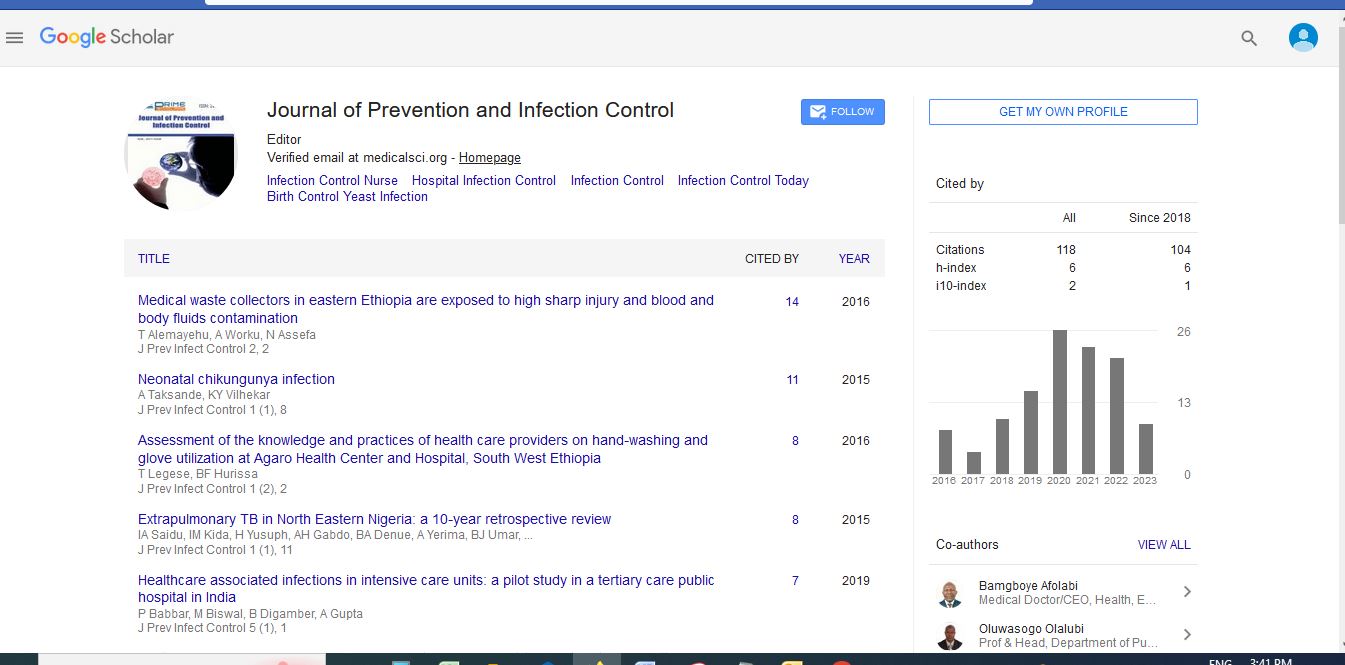Commentary - (2024) Volume 10, Issue 4
Hand Hygiene: A Simple Yet Effective Strategy for Infection Prevention
Ethan Miller*
Department of Infection Prevention and Control, University of California, United States
*Correspondence:
Ethan Miller,
Department of Infection Prevention and Control, University of California,
United States,
Email:
Received: 02-Dec-2024, Manuscript No. IPJPIC-25-22455 ;
Editor assigned: 04-Dec-2024, Pre QC No. IPJPIC-25-22455 (PQ);
Reviewed: 18-Dec-2024, QC No. IPJPIC-25-22455 ;
Revised: 23-Dec-2024, Manuscript No. IPJPIC-25-22455 (R);
Published:
30-Dec-2024, DOI: 10.36648/2471-9668-10.4.32
Description
Hand hygiene is one of the most effective ways to prevent the
spread of infections and maintain overall health. Proper hand
hygiene is a fundamental practice in healthcare, food industries,
and everyday life. It significantly reduces the risk of transmitting
pathogens that cause diseases. This article explores the
importance of hand hygiene, proper handwashing techniques,
its impact on health, and best practices for maintaining hygiene
in various settings. Hands are one of the primary pathways for
germ transmission. People frequently touch their faces, food,
and various surfaces, making it easy for microorganisms to
transfer from one location to another. Inadequate hand hygiene
can lead to the spread of infections such as the flu, common
cold, gastrointestinal diseases, and even serious conditions like
COVID-19. Hand hygiene is particularly critical in healthcare
settings, where healthcare-associated infections (HAIs) pose
a significant risk to patients. The World Health Organization
(WHO) and the Centers for Disease Control and Prevention
(CDC) emphasize the role of hand hygiene in preventing HAIs
and improving patient safety. Several bacteria, viruses, and fungi
can be transmitted through hands. Some common pathogens
includes causes gastrointestinal infections and food poisoning.
Can lead to skin infections, pneumonia, and bloodstream
infections. Responsible for foodborne illnesses. A leading cause
of viral gastroenteritis. Causes seasonal flu outbreaks. Spread
through respiratory droplets and contaminated surfaces.
Proper hand hygiene helps break the chain of transmission for
these pathogens, reducing infection risks. To effectively remove
germs, it is crucial to wash hands correctly. The WHO and CDC
recommend the following steps are Before eating or preparing
food, After using the toilet, After coughing, sneezing, or blowing
your nose, After handling garbage, Before and after caring for a
sick person, After touching pets or handling their waste, After
being in a public place or touching frequently used surfaces like
doorknobs, light switches, and shopping carts. Use clean, running
water (warm or cold) to wet your hands. Use enough soap to
cover all hand surfaces. Lather and scrub rub hands together to
create lather, ensuring to clean between fingers, under nails, and
the backs of hands. Scrub for at least 20 seconds a good reference
is singing the â??Happy Birthdayâ? song twice. Rinse thoroughly use
clean water to wash off all soap. Dry hands use a clean towel
or air dry them. When soap and water are unavailable, alcoholbased
hand sanitizers are an effective alternative. However,
sanitizers are not as effective against certain pathogens like
norovirus and Clostridium difficile. To use hand sanitizer
effectively apply a generous amount of sanitizer to the palm,
Rub hands together, covering all surfaces, Continue rubbing
until hands are dry. Numerous studies confirm that proper hand
hygiene reduces the spread of infectious diseases. According to
the CDC, handwashing reduces diarrheal diseases by 30â??40% and
respiratory infections by 20%. This simple habit has saved millions
of lives worldwide. Frequent infections lead to the overuse of
antibiotics, contributing to antimicrobial resistance (AMR). By
preventing infections through proper hand hygiene, the need for
antibiotics is reduced, helping in the fight against AMR. Young
children, elderly individuals, and immunocompromised patients
are more susceptible to infections. Ensuring proper hand hygiene
in hospitals, nursing homes, and childcare facilities is vital in
protecting these vulnerable groups.
Acknowledgement
None.
Conflict Of Interest
The author declares there is no conflict of interest.
Citation: Miller E (2024) Hand Hygiene: A Simple Yet Effective Strategy for Infection Prevention. J Prevent Infect Control. 10:32.
Copyright: © 2024 Miller E. This is an open-access article distributed under the terms of the Creative Commons Attribution License, which permits unrestricted use, distribution, and reproduction in any medium, provided the original author and source are credited.

